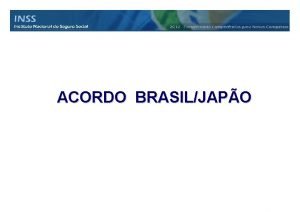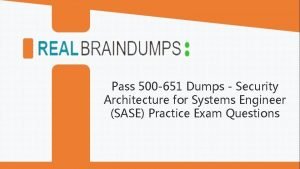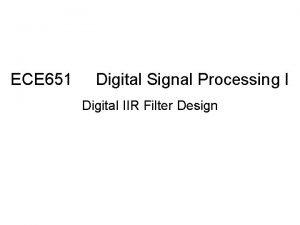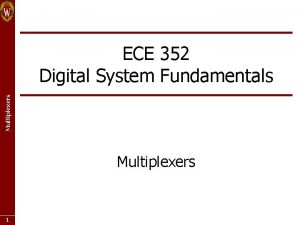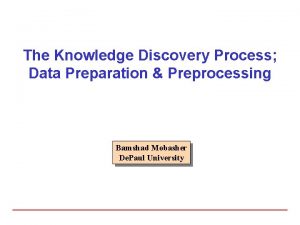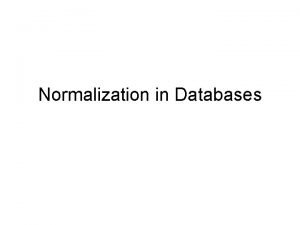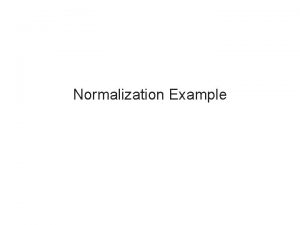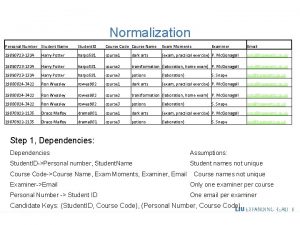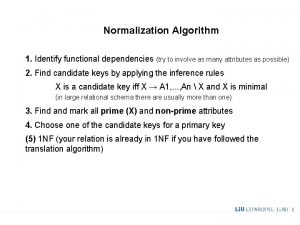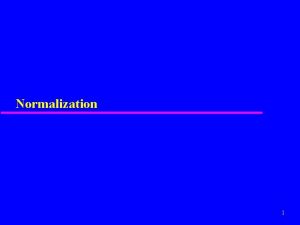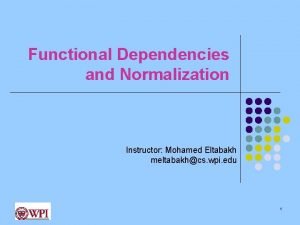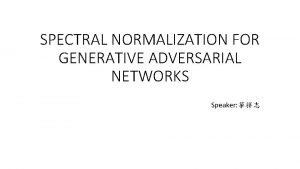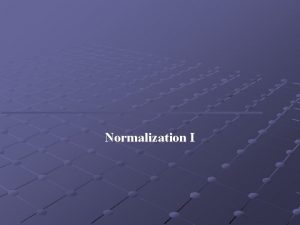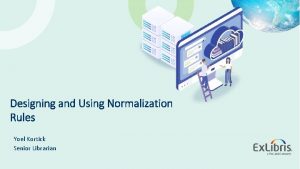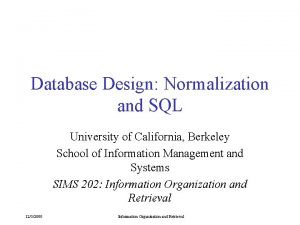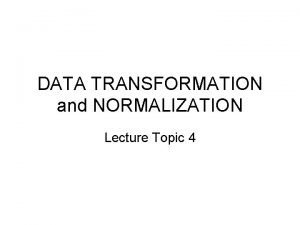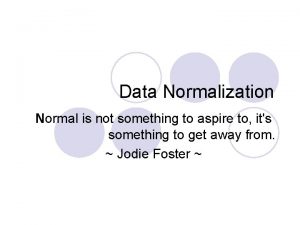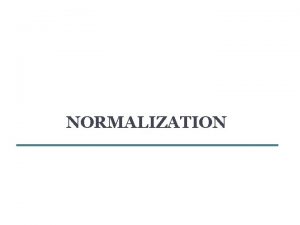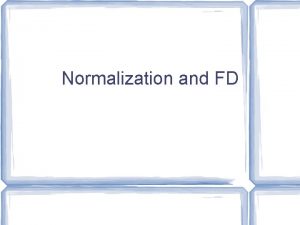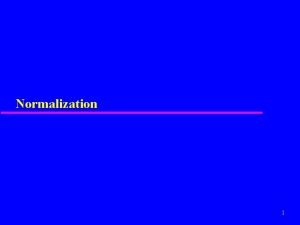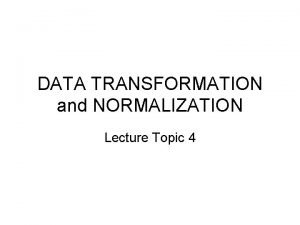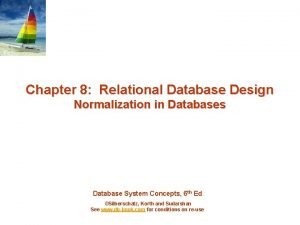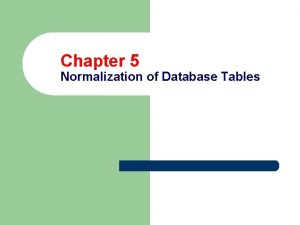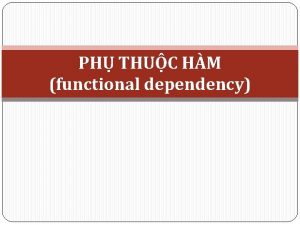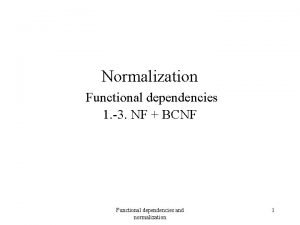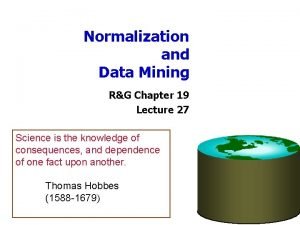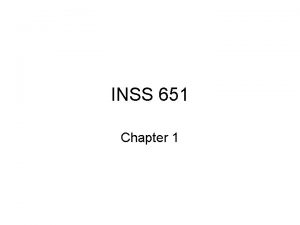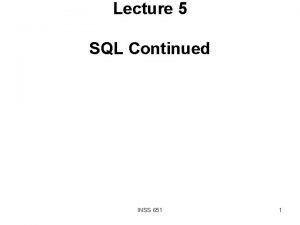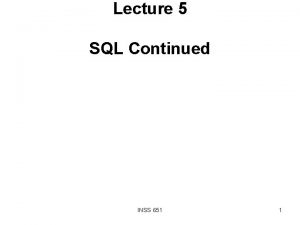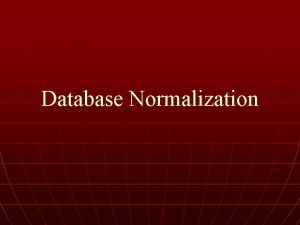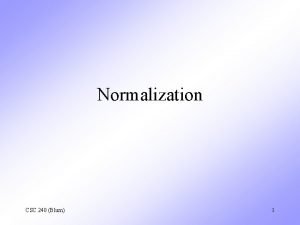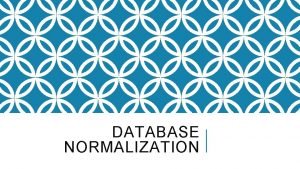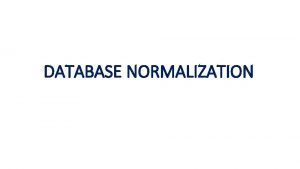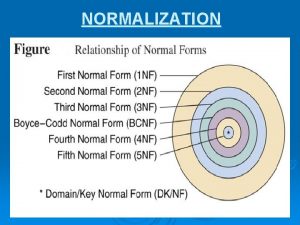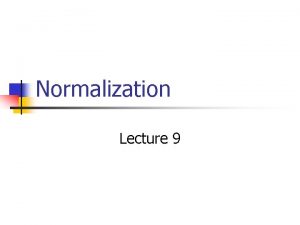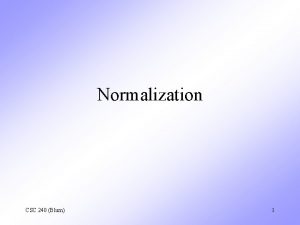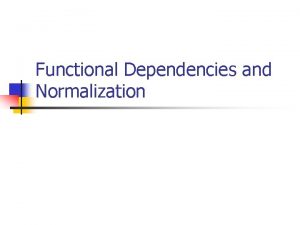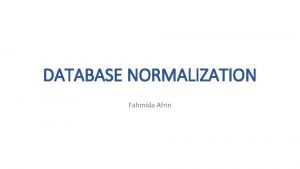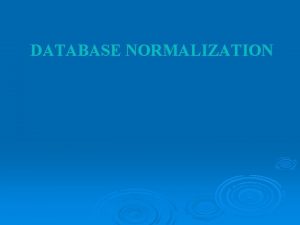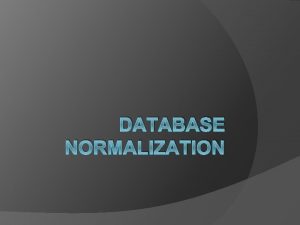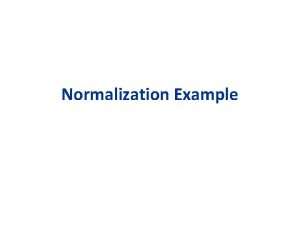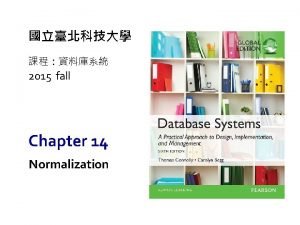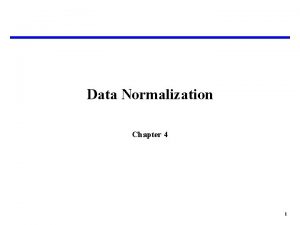Chapter 5 Normalization An Normalization example INSS 651


































- Slides: 34

Chapter 5 • Normalization • An Normalization example INSS 651 1

Learning Objectives • What normalization is and what role it plays in the database design process • About the normal forms 1 NF, 2 NF, 3 NF, BCNF, and 4 NF • How normal forms can be transformed from lower normal forms to higher normal forms • That normalization and ER modeling are used concurrently to produce a good database design • That some situations require denormalization to generate information efficiently INSS 651 2

Normalization A process for evaluating and correcting table structure Minimize data redundancy Eliminate Anomalies INSS 651 3

Is Normalization Necessary? NO But it is helpful to maintain data integrity and consistency INSS 651 4

Anomalies • Update—requires update in multiple locations • Deletion—A deletion may lose important information • Insertion—Requires complete definitions, ie does see page 187 (an employee can not be entered unless he is assigned a project INSS 651 5

Normalization Process • 1 st NF • 2 nd NF • 3 rd NF • Almost for 90 -98% application 3 rd NF is sufficient INSS 651 6

Dependency When an attribute value depends on attribute B then B is dependent on A A--- B or values of B can be determined by value of A, reverse may or may not be true Ex: ssn-- Name SSN, CID-- Grade INSS 651 7

Un-normalized relation Remove REPEATING groups 1 st NF Remove PARTIAL dependency 2 nd NF Remove TRANSIENT dependency 3 rd NF Every determinant is a candidate key Boyce-CODD NF If we can convert a relation into 3 NF almost 90 -98% of anomalies are removed INSS 651 8

The Need for Normalization (continued) • Structure of data set in Figure 5. 1 does not handle data very well • The table structure appears to work; report is generated with ease • Unfortunately, the report may yield different results, depending on what data anomaly has occurred INSS 651 9

1 st NF • Remove repeating groups ASSIGNMENT (Proj_num, proj_name(Emp_num, E_name, job_class, c hg_hours, Hour)) INSS 651 10

A Dependency Diagram: First Normal Form (1 NF) INSS 651 11

Second Normal Form (2 NF) Conversion Results INSS 651 12

Third Normal Form (3 NF) Conversion Results INSS 651 13

Un-normalized form A relation is in un-normalized form, if it contains repeating group Typically shown in parentheses Ex: PART NO DESC. VENDOR-NAME ADDRESS UNIT-COST 1234 LOGIC chip INTEL LSI LOGIC 5678 MEMORY INTEL chip INSS 651 SAN JOSE 150. 00 SAN JOSE 120. 00 SAN JOSE 50. 00 14

SUPPLIER (Part_no, Part_DESC, (Vendor_name, Vendor_address, Unit_cost)) INSS 651 15

Another Way (Part_NO, V_NAME)-> Unit_cost Part_NO->P_Desc (Partial dependency) V-Name->V_DESC (Partial Dependency) Part_NO P-DESC V_NAME V_ADDRESS INSS 651 UNIT_COST 16

1 st NF A relation is in 1 st NF if it does NOT contain any repeating groups (Part_no, Part_DESC, (Vendor_name, Vendor_address, Unit_cost)) 1 st NF. . remove repeating groups Break it into TWO relations One without repeating group and ONE with repeating group AND PK of other relation S 1 (Part_no, Part_DESC) S 2 (Vendor_name, Part_no, Vendor_address, Unit_cost INSS 651 17

2 nd NF A relation is in 2 nf NF if it is in 1 st. NF and it does not contain any partial dependency Partial dependency: A partial dependency exists if an attribute is dependent ONLY on PART of the PK and the WHOLE PK We must examine each relation for partial dependency NOTE: A partial dependency can only exist if there are more than ONE attribute as PK INSS 651 18

S 1 (Part_no, Part_DESC) S 2 (Vendor_name, Part_no, Vendor_address, Unit_cost Note S 1 is already in 2 nd NF since there is only attribute as PK In S 2: Question is Vendor_address dependent on BOTH vendor_name AND Part_NO? Question is Unit_price dependent on BOTH vendor_name AND Part_NO? INSS 651 19

Question is Vendor_address dependent on BOTH vendor_name AND Part_NO? Answer: NO Give me vendor_no and I can find vendor_address, we do NOT need Part_No to know vendor_address, ie Vendor_address depends ONLY Vendor_name, hence the partial dependency INSS 651 20

Question is Unit_price dependent on BOTH vendor_name AND Part_NO? YES if you examine the table, price changes with vendor and part_no, ie price depnds on both Part_no AND which vendor supplies it INSS 651 21

Remove Partial Dependency VENDOR _ADDRESS VENDOR_name UNIT_PRICE PART# Create TWO tables: One with Partial dependency and other without it S 21 (Vendor_name, vendor_address) S 22(Vendor_name, Part_no, Unit_price) INSS 651 22

3 rd NF A relation is in 3 rd NF if it is in 2 nd NF and it does not contain any transitive dependency Transitive dependency: A transitive dependency exists when some of the nonkey attributes are dependent on other nonkey attributes INSS 651 23

So far we have three relations that are in at least 2 nd NF S 1 (Part_no, Part_DESC) S 21 (Vendor_name, vendor_address) S 22(Vendor_name, Part_no, Unit_price) S 1, S 21 & S 22 are also in 3 rd NF since there is ONLY ONE non_key attribute and transitive dependency can NOT exist INSS 651 24

ERD PART-SUPPLIED INSS 651 VENDOR 25

Q 6/p 184 A Using notation from the book a. (C 1, C 3)- C 2, C 4, C 5 (i. e. , C 2, C 4, C 5) are functionally dependent on C 1 and C 3 Above relation is in at least 1 st. NF, since there are No repeating groups C 1 C 2 there is PARTIAL dependency since C 2 depends on PART of the PK and the whole PK C 4 -- C 5 (transitive dependency since C 5 ( a non-PK attribute) depends on another non-PK attribute (C 4) INSS 651 26

Part b INSS 651 27

Part c INSS 651 28

Q 8/P 187 Table P 5. 8 Sample ITEM Records Sample Value ITEM_ID 231134 -678 342245 -225 254668 -449 ITEM_LABEL HP Desk. Jet 895 Cse HP Toner DT Scanner ROOM_NUMBER 325 123 BLDG_CODE NTC CSF BLDG_NAME Nottooclear Nottoclear Canseefar BLDG_MANAGER I. B. Rightonit May B. Next Attribute Name INSS 651 29

Problem 8 Solution ITEM_ID ITEM_DESCRIPTION BLDG_ROOM BLDG_CODE BLDG_NAME BLDG_MANAGER INSS 651 30

ITEM_ID ITEM_DESCRIPTION BLDG_ROOM BLDG_CODE BLDG_NAME BLDG_MANAGER Problem 9 Solution: All tables in 3 NF ITEM_ID ITEM_DESCRIPTION BLDG_ROOM BLDG_CODE BLDG_NAME EMP_CODE EMP_LNAME EMP_FNAME INSS 651 EMP_INITIAL 31

INSS 651 32

Denormalization • Reversing normalization • i. e from 3 rd NF to 2 nd NF • Or 2 nd to 1 st NF INSS 651 33

Convert into 3 NF INVOICE (Inv_num, cust_num, lastname, Firstname, street, city, s tate, zip, date, (partnum, description, price, numshipped)) INSS 651 34
 Meralgia parestésica inss
Meralgia parestésica inss Cif modelo biopsicossocial
Cif modelo biopsicossocial Organograma do inss
Organograma do inss Security architecture for systems engineer sase 500 651
Security architecture for systems engineer sase 500 651 Ece 651
Ece 651 Ece 352
Ece 352 Lei 12 651
Lei 12 651 Data characterization
Data characterization What is unnormalized data
What is unnormalized data What is normalization in dbms
What is normalization in dbms Normalization example with solution
Normalization example with solution Normalization example with solution
Normalization example with solution Purpose of normalization
Purpose of normalization Normalization example with solution
Normalization example with solution Bees lca
Bees lca Spectral normalization
Spectral normalization Risk normalization examples
Risk normalization examples Primo ve normalization rules
Primo ve normalization rules The purpose of normalization
The purpose of normalization Normalization of deviance ppt
Normalization of deviance ppt Normalization rules alma
Normalization rules alma Normalization in sql
Normalization in sql Data transformation by normalization
Data transformation by normalization Normalization
Normalization Normalization constant
Normalization constant Purpose of normalization
Purpose of normalization Purpose of normalization
Purpose of normalization Purpose of normalization
Purpose of normalization Data transformation by normalization
Data transformation by normalization Candidate key in database
Candidate key in database Normalization of database tables
Normalization of database tables Normalization
Normalization Functional dependencies and normalization
Functional dependencies and normalization Partial dependency normalization
Partial dependency normalization 3 weeks from today
3 weeks from today


